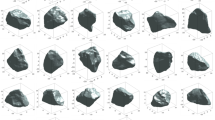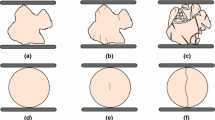Abstract
Cure cast plastic bonded explosives (PBXs) consist of relatively hard particles in a soft binder. Under compressive loading, the explosive cyrstals come into contact that causes high stress concentrations. The lines along which the crystals are loaded are called stress chains. Damage done to these particle beds during compressive loading can lead to reaction. The photoelastic effect of PMMA is exploited to examine the stress state within a two-dimensional particle bed. Stress chain development within the bed is recorded and is shown to increase the stress state within some particles while leaving others unloaded. These concentrations form early in the loading process, leading to fracture along the stress bridges and generating likely reaction initiation sites. Through material point method simulations, contact friction is shown to have a large effect on the stress distribution within the particle bed.
Similar content being viewed by others
References
Haeger, H.M., Nagel, S.R., and Behringer, R.P., “The Physics of Granular Materials” Physics Today,49 (32) (1996).
Sienkiwicz, F., Shukla, A., Sadd, M., Zhang, Z., andDvorkin, J., “A Combined Experimental and Numerical Scheme for the Determination of Contact Loads Between Cemented Particles,”Mechanics of Materials,22 (43),43–50 (1996).
Foster, J.C., Glenn, J.G., and Gunger, M. “Meso-scale Origins of the Low Pressure Equation of State and High Rate Mechanical Properties of Plastic Bonded Explosives”. In Shock Compression in Condensed Matter-1999, M.D., Furnish, L.C. Chhabildas, and R.S. Hixson, eds., Proceedings of the Conference of the American Physical Society, pp. 703–706. Air Force Research Lab/Munitions Directorate (1999).
Davis, W.C., “High Explosives: The Interaction of Chemistry and Mechanics”, Los Alamos Science,2 (1) (1981).
Christopher, F.R., Jr., Foster, J.C., Wilson, L.L., and Gilland, H.L. “The Use of Impact Techniques to Characterize the High Rate Mechanical Properties of Plastic Bonded Explosives”. In Proceeding of the 11th International Detonation Symposium, J.M. Short and J.E. Kennedy, eds., (1998).
Roessig, K.M., Foster, Jr., J.C., and Wilson, L.L. “High Strain Rate Behavior of Plastic Bonded Explosives”. In Int. Workshop on New Models for Shock Wave/Dynamic Processes in Energetic Materials and Related Solids, S. Coffey, R. Armstrong, and V.Y. Klimenko, eds., University of Maryland (1999).
Ho, S.Y., “Impact ignition of rocket propellants,”Combustion and Flame,91,131–142 (1992).
Rae, P.J., Goldrein, H.T., Palmer, S.J.P., and Proud, W. “Moire Interferometry Studies of pbx 9501”, In Shock Compression of Condensed Matter—2001. AIP Conference Proceedings (2001).
Rossmanith, H.P. and Shukla, A., “Photoelastic Investigation of Dynamics Load Transfer in Granular Media,” Acta Mechanica,42 (211) (1982).
Shukla, A., Sadd, M.H., andMei, H., “Experimental and Computational Modeling of Wave Propagation in Granular Materials,” EXPERIMENTAL MECHANICS,47 (4),377–381 (1990).
Zhu, C.Y., Shukla, A., andSadd, M.H., “Prediction of Dynamic Contact Loads in Granular Assemblies,”J. Applied Mechanics,58,341–346 (1991).
Shukla, A., andDamania, C., “Experimental Investigation of Wave Velocity and Dynamic Contact Stresses in an Assembly of Disks,” EXPERIMENTAL MECHANICS,44 (3),268–281 (1987).
Shukla, A., Sadd, M.H., Xu, Y., andTai, Q.M., “Influence of Loading Pulse Duration on Dynamic Load Transfer in a Simulated Granular Medium,”J. Mechanics and Physics of Solids,41 (1),1795–1808 (1993).
Shukla, A., Sadd, M.H., Singh, R., Tai, Q., and Vishwanathan, S. “Role of Particle Shape and Contact Profile on the Dynamic Response of Particulate Materials” Optics and Lasers in Engineering,19 (99) (1993).
Xu, Y. andShukla, A., “Evaluation of Static and Dynamic Contact Stresses in Simulated Granular Particles Using Strain Gages”,J. Testing and Evaluation,21 (3),178–187 (1993).
Khanna, S.K. andShukla, A., “On the Use of Strain Gages in Dynamic Fracture Mechanics,”Engineering Fracture Mechanics,51 (6),933–948 (1995).
Shukla, A. andPrakash, V., “Wave Propagation in Porous Media as a Function of Fluid Saturation,” EXPERIMENTAL MECHANICS,47 (1),80–87 (1990).
Sadd, M.H. andShukla, A. “On the Role of Pore Fluid and Interparticle Cemenetation on Wave Propagation in Granular Materials,”AMD-Vol. 188, Wave Propagation and Emerging Technologies,188,11–28 (1994).
Zhu, C.Y., Chona, R., andShukla, A., “Influence of Singularity Dominated Zone for Propagating Cracks in Finite Size Specimens,”Theoretical and Applied Fracture Mechanics,16,167–177 (1991).
Shukla, A. andKavaturu, M., “Opening-mode, Dominated Crack Growth Along Inclined Interfaces: Experimental Observations,”Int. J. Solids and Structures,35 (30),3961–3975 (1998).
Signh, R., Lambros, J., Shukla, A., andRosakis, A., “Investigation of the Mechanics of Intersonic Crack Propagation Along a Bimaterial Interface Using Coherent Gradient Sensing and Photoelasticity,”Proc. R. Soc. Lond., A,453,2649–2667 (1997).
Dally, J.W. andRiley, W.F., Experimental Stress Analysis, McGraw-Hill Book Company, New York (1965).
Lee, G.H. An Introduction to Experimental Stress Analysis.John Wiley & Sons, Inc., New York (1950).
Timoshenko, S. P. andGoodier, J.N. Theory of Elasticity.McGraw-Hill Book Company, New York, 3rd edition (1970).
Johson, K.L. Contact Mechanics.Cambridge University Press, Cambridge, United Kingdom (1985).
Blumenthal, W.R., Cady, C.M., Lopez, M.F., Gray III, G.T., and Idar, D.J. “Influence of Temperature and Strain Rate on the Compressive Behavior of pmma and Polycarbonate Polymers”. In Shock Compression of Condensed Matter—2001. AIP Conference Proceedings (2001).
Boyle, V., Frey, R., and Blake, O. Combined Pressure Shear Ignition of Explosives (1989).
Bardenhagen, S.G., Brackbill, J.U., andSulsky, D., “Numerical Study of Stress Distribution in Sheared Granular Material in Two Dimensions,”Physical Review E,62 (3),3882–3890 (2000).
Roessig, K.M. “Mesoscale Mechanics of Plastic Bonded Explosives”. In Shock Compression of Condensed Matter—2001. AIP Conference Proceedings (2001).
Bardenhagen, S.G. andBrackbill, J.U., “Dynamic Stress Bridging in Granular Material,” J. Applied Physics.,83 (11),5732–5740 (1998).
Coffey, C.S., andSharma, J., “Plastic Deformation, Energy Dissipation, and Initiation of Crystalline Explosives,”Physical Review B,60 (13),9365–9371 (1999).
Author information
Authors and Affiliations
Rights and permissions
About this article
Cite this article
Roessig, K.M., Foster, J.C. & Bardenhagen, S.G. Dynamic stress chain formation in a two-dimensional particle bed. Experimental Mechanics 42, 329–337 (2002). https://doi.org/10.1007/BF02410990
Received:
Revised:
Issue Date:
DOI: https://doi.org/10.1007/BF02410990




